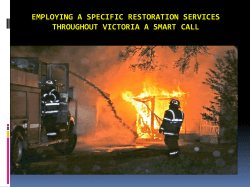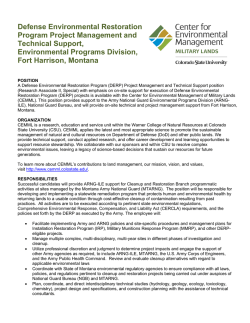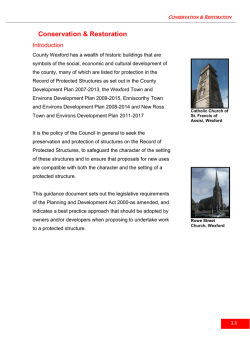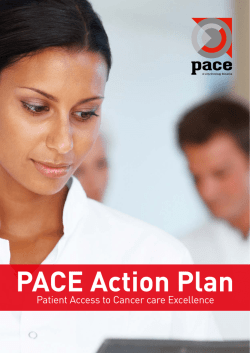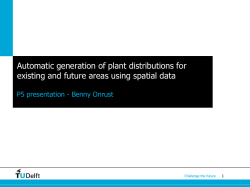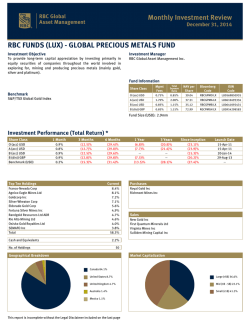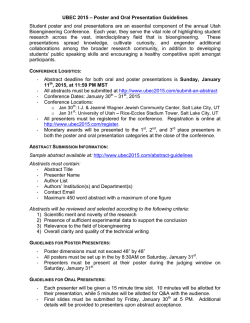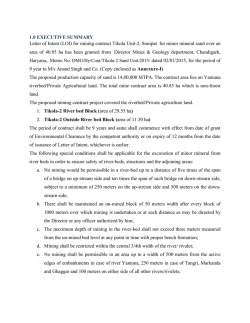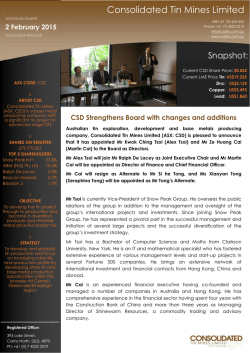
course brochure - Mine Closure 2015
NATURAL PROCESS FOR THE RESTAURATION OF DRASTICALLY DISTURBED SITES Presented by: When: Where: David Polster, M.Sc., R.P. Bio. Polster Environmental Services, Ltd. Sunday, May 31, 2015 Hyatt Regency Vancouver TECHNICAL BACKGROUND Natural processes have been “restoring” natural disturbances since the advent of terrestrial vegetation over 400 million years ago. This workshop will explore how these natural processes, systems and functions can be used to restore sites that humans have disturbed such as large mines, industrial disturbances, landslides, shorelines and other disturbed sites. We will look at how natural systems address filters to recovery such as erosion and steep, unstable slopes and how we can design restoration treatments that address these filters. We will explore the natural processes that provide nutrients and nutrient cycling capacity to ecosystems and how these can be re-established on drastically disturbed sites. In many cases restoration treatments based on these natural processes can be used to restore anthropogenic disturbances more easily and at a lower cost than traditional reclamation treatments. Examples will be drawn from the experience (over 37 years) of the instructor in the mining and heavy construction industry. PARTICIPANTS This course will be of interest to those engaged in the restoration of disturbed sites. Managers or other personnel from large mines or other sites where disturbances must be reclaimed will be interested in this course. Regulators and others looking for effective restoration strategies will find this course useful. LEARNING OUTCOMES The course provides a methodology for the restoration of drastically disturbed sites (mines, industrial sites, landslides, etc.) based on the natural recovery processes that operate in ecosystems throughout the world. Natural process based restoration is often less expensive that traditional treatments and provides for the long-term recovery of the site, including soil and vegetation development. SPECIFIC OUTCOMES Participants will learn a variety of treatments to control erosion, re-establish vegetation and build soilforming processes. Specific details are provided to address issues that are commonly found at mines and industrial sites (e.g. compaction, steep slopes, adverse soil texture, toxic materials and lack of organic matter or “soils”). CONTENT AND PROGRAM The workshop will be a full day (08:30 to 17:15 with breaks) and will follow the schedule outlined below. 07:30-08:30 Registration 08:30-10:30 Session 1. A brief review of ecosystem formation processes (assembly rules); The use of a successional model to inform restoration design. 10:30-11:00 Coffee break 11:00-12:30 Session 2. The role of nitrogen fixing pioneering species in restoration systems; Erosion processes and solutions. 12:30-13:30 Lunch 13:30-15:00 Session 3. Strategies to address climatic and seasonality constraints; Restoration of difficult sites (introduction to Soil Bioengineering). 15:00-15:30 Coffee break 15:30-17:15 Session 4. Implementation, maintenance and monitoring of restored sites; Incorporation of social values in the restoration of drastically disturbed sites. METHODOLOGY The course is presented as a series of PowerPoint presentations (approximately 1,250 slides) based on the experience of the instructor. These show photographs of a variety of restoration sites over many years so that participants can see how the restoration treatments performed (good and bad) and how the principles that are being taught have been used in a variety of different situations. COURSE MATERIALS Participants will receive a course manual (123 pp) that provides referenced details of the materials presented in the course. In addition, the instructor will bring his library of restoration related books for viewing by the participants during breaks. EQUIPMENT A room that can be darkened and a PowerPoint projector and screen are the only equipment needed (in a large room with many participants, a microphone may be needed). Participants may want to bring a writing implement to make notes. INSTRUCTOR’S BIO NOTES David F. Polster, R.P. Bio. #148 is a plant ecologist with over 37 years of experience in vegetation studies, reclamation and invasive species management. He graduated from the University of Victoria with an Honours Bachelor of Science degree in 1975 and a Master of Science degree in 1977. He has developed a wide variety of reclamation techniques for mines, industrial developments and steep/unstable slopes as well as techniques for the re-establishment of riparian and aquatic habitats. He is the pastpresident (third term) of the Canadian Land Reclamation Association. He is the treasurer for the Western Canada Chapter of the Society for Ecological Restoration and is the NW Regional Representative on the board of the international Society for Ecological Restoration (SER). He was recently awarded the prestigious John Rieger Award from SER. He serves as the alternate mining representative on the board of the Invasive Species Council of B.C. Dave has provided on-site design and direction in the development of reclamation and bioengineering systems for restoration of severely damaged ecosystems. He served as the environmental supervisor for CP Rail's massive Roger's Pass Project. He was responsible for developing the bioengineering systems that have successfully revegetated a portion of the Point Grey cliffs at UBC. Dave has prepared reclamation plans for numerous mines, quarries and gravel pits in Canada. He pioneered the concept of successional reclamation where the aim of the reclamation program is the re-integration of the disturbed site into the natural processes of vegetation succession. He has applied his knowledge in ecology to solving problems of unwanted and invasive vegetation. He has authored numerous papers and teaches graduate level courses on these topics.
© Copyright 2025
